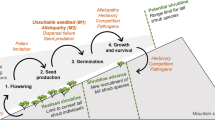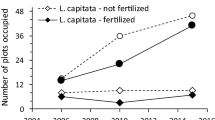Abstract
Identifying the environmental constraints that affect the distribution of an invasive species is fundamental to its effective control. Triadica sebifera (Chinese tallow tree) has invaded the southeastern United States, but its potential for further range and habitat extension has been unresolved. We explored experimentally environmental factors in macro- and microhabitats that affect its persistence at five widely separated sites along the Atlantic seaboard of the United States and at two sites inland; three sites occur well beyond the tree’s current range. At each site, seeds and young vegetative plants (0.5–0.65 m tall) of T. sebifera were placed in four microhabitats (closed-canopy upland, closed-canopy lowland, open-canopy upland, and open-canopy lowland). Plant growth, leaf CO2 assimilation rates, leaf N concentrations and δ13C ratios, and stem water potential were measured for two growing seasons. Percent seed germination was consistently higher in open-canopy microhabitats and lowest at northern and inland sites. T. sebifera grew in all open-canopy microhabitats, even 300–500 km beyond its current distribution. Plant growth in closed-canopy habitats was lower, attributable to lower carbon gain per unit leaf area in shaded compared with open-canopy environments, especially at northern and inland sites. Neither competition, other than canopy shade, nor grazing was a key constraint on distribution at any scale. Our results demonstrate that T. sebifera is dispersal limited at landscape scales but limited locally by dispersal and overstory shade; it has yet to occupy the full extent of its new range in North America. Quantifying environmental factors both within and well beyond a species’ current range can effectively highlight the limits on its distribution.





Similar content being viewed by others
References
Brooker RW, Maestre FT, Callaway RM et al (2007) Facilitation in plant communities: the past, the present, and the future. J Ecol 96:18–34
Bruce KA, Cameron GN, Harcombe PA, Jubinsky G (1997) Introduction, impact on native habitats, and management of a woody invader, the Chinese tallow tree, Sapium sebiferum. Nat Areas J 17:255–260
Conner WH, Mixon WD, Wood GW (2005) Maritime forest habitat dynamics on Bulls Island, Cape Romain National Wildlife Refuge, SC following Hurricane Hugo. For Ecol Manage 212:127–134
Daubenmire R (1959) A canopy-coverage method. Northwest Sci 33:43–64
Dawson TE, Mambelli S, Plamboeck AH, Templer PH, Tu KP (2002) Stable isotopes in plant ecology. Annu Rev Ecol Syst 33:507–509
Evans JR, Sharkey TD, Berry JA, Farquhar GD (1986) Carbon isotope discrimination measured concurrently with gas ex-change to investigate CO2 diffusion in leaves of higher plants. Aust J Plant Physiol 13:281–292
Gaston KJ (2003) The structure and dynamics of geographic ranges. Oxford University Press, Oxford
Goldberg DE, Scheiner SM (2001) ANOVA and ANCOVA field competition Experiments. In: Scheiner SM, Gurevitch J (eds) Design and analysis of ecological experiments, 2nd edn. Oxford University Press, Oxford, pp 77–98
Guo Q, Taper M, Schoenberger M, Brandle J (2005) Spatial–temporal population dynamics across species range: from centre to margin. Oikos 108:47–57
Hairston NG (1989) Ecological experiments: purpose, design, and execution. Cambridge University Press, New York
Harper JL (1982) After description. In: Newman EI (ed) The plant community as a working mechanism. British Ecological Society Special Publications, vol 1. Blackwell, Oxford, pp 11–25
Harper JL, Silvertown J, Franco M (1997) Preface. In: Silvertown J, Franco M, Harper JL (eds) Plant life histories: ecology, phylogeny, and evolution. Cambridge University Press, New York, pp 11–18
Hobbie SE, Gough L (2002) Foliar and soil nutrients in tundra on glacial landscapes of contrasting ages in northern Alaska. Oecologia 131:453–462
Humphries SE, Groves RH, Mitchell DS (1991) Plant invasions: the incidence of environmental weeds in Australia. Kowari 2. Australian National Parks and Wildlife Service, Canberra
Hunt R (1982) Plant growth curves: the functional approach to plant growth analysis. University Park Press, Baltimore
Intergovernmental Panel on Climate Change [IPPC] (2001) Climate change 2001: synthesis report summary for policy makers. http://www.ipcc.ch/
Jones RH (1993) Influence of soil temperature on competition in seedlings of Acer rubrum, Liquidambar styraciflua and Sapium sebiferum. Am Midl Nat 130:116–126
Jones RH, McLeod KW (1990) Growth and photosynthetic responses to a range of light environments in Chinese tallow tree and Carolina ash seedlings. For Sci 36:851–862
Mack RN (1981) Invasion of Bromus tectorum L. into western North America: an ecological chronicle. Agro-Ecosyst 7:145–165
McFadyen RC, Skarratt B (1996) Potential distribution of Chromolaena odorata (siam weed) in Australia, Africa and Oceania. Agric Ecosyst Environ 59:89–96
Moody ME, Mack RN (1988) Controlling the spread of plant invasions: the importance of nascent foci. J Appl Ecol 25:1009–1021
Patterson DT (1994) Temperature responses and potential range of the grass weed, serrated tussock (Nasella trichotoma), in the United States. Weed Technol 8:703–712
Pattison RR (2003) Ecological constraints on the distribution of the Chinese tallow tree (Sapium sebiferum) in the southeastern USA. PhD dissertation. Washington State University, Pullman
Pattison RR, Mack RN (2008) Potential distribution of the invasive tree Triadica sebifera (Euphorbiaceae) in the United States: evaluating CLIMEX predictions with field trials. Glob Change Biol 14:813–826
Radford AE, Ahles HE, Bell CR (1968) Manual of the vascular flora of the Carolinas. University of North Carolina Press, Chapel Hill
Renne IJ, Gauthreaux SA, Gresham CA (2000) Seed dispersal of the Chinese tallow tree (Sapium sebiferum (L.) Roxb.) by birds in coastal South Carolina. Am Midl Nat 144:202–215
Renne IJ, Spira TP, Bridges WC (2001) Effects of habitat, burial, age and passage through birds on germination and establishment of Chinese tallow tree in coastal South Carolina. J Torrey Bot Soc 128:109–119
Renne IJ, Barrow WC, Johnson-Randall LA, Bridges WC (2002) Generalized avian dispersal syndrome contributes to Chinese tallow tree (Sapium sebiferum, Euphorbiaceae) invasiveness. Divers Distrib 8:285–295
Rousett O, Lepart J (2007) Positive and negative interactions at different life stages of a colonizing species (Quercus humilis). J Ecol 88:401–412
Sakai A (1982) Freezing resistance of ornamental trees and shrubs. J Am Soc Hortic Sci 107:572–581
Samuels I (2004) Invasion of Chinese tallow (Sapium sebiferum): a test of dispersal and recruitment limitation in multiple habitats. MS thesis. University of Florida, Gainesville. http://etd.fcla.edu/UF/UFE0004706/samuels_i.pdf
Siemann E, Rogers WE (2003a) Changes in light and nitrogen availability under pioneer trees may indirectly facilitate tree invasions of grasslands. J Ecol 91:923–931
Siemann E, Rogers WE (2003b) Herbivory, disease, recruitment limitation, and the success of alien and native tree species. Ecology 84:1489–1505
Simberloff D (2003) Why not eradication? In: Rapport DJ, Lasley BL, Rolston DE et al (eds) Managing for healthy ecosystems. Lewiss, Boca Raton, pp 541–548
Turner NC (1988) Measurement of plant water status by the pressure chamber technique. Irrigation Sci 9:289–308
Vetaas OR (2002) Realized and potential climate niches: a comparison of four Rhododendron tree species. J Biogeogr 29:545–554
Welk E, Schubert K, Hoffmann MH (2002) Present and potential distribution of invasive garlic mustard (Alliaria petiolata) in North America. Divers Distrib 8:219–233
Woodward FI (1990) The impact of low temperatures in controlling the geographical distribution of plants. Proc R Soc Lond B 326:585–593
Acknowledgments
We thank M. Burke (USFS), J. Wiemer (Paynes Prairie State Preserve), K. McLeod (Savannah River Ecology Laboratory), W. Conner and the staff of the Belle W. Baruch Institute for Coastal and Marine Sciences, K. Cox (Clemson University Forest), the Hofmann Forest staff, T. Sanders (Ft. Eustis Army Base), D.F. Whigham and J.P. O’Neill and the staff at the Smithsonian Environmental Research Center (SERC). We also thank K.D. Rode and J.J. Brunette for valuable assistance in all stages of research and M. Evans (Washington State University) and M.S. Minton (SERC) for statistical consulting. We thank D.G. Williams and J.P. Sparks, R.K. Monson, M. Lerdau and two anonymous reviewers for constructive criticism. This research was supported by grants to R.R.P. from the Betty Higinbotham Trust, the Florida Exotic Pest Plant Council and a Natural Resources Conservation Grant at WSU. Experiments reported in this work comply with the current laws of the United States of America.
Author information
Authors and Affiliations
Corresponding author
Additional information
Communicated by Manuel Lerdau.
Rights and permissions
About this article
Cite this article
Pattison, R.R., Mack, R.N. Environmental constraints on the invasion of Triadica sebifera in the eastern United States: an experimental field assessment. Oecologia 158, 591–602 (2009). https://doi.org/10.1007/s00442-008-1187-7
Received:
Accepted:
Published:
Issue Date:
DOI: https://doi.org/10.1007/s00442-008-1187-7




